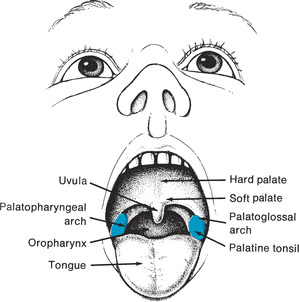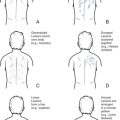The alert practitioner will detect concerns during the complete health assessment of children and adolescents that might lead to determination of the need for a more focused assessment of mental health. The cognitive and emotional development of children and adolescents produce greater variability in assessment of mental health and can make interpretation challenging; because of this, multiple approaches are recommended to increase reliability in findings. There are many standardized tests available that can be utilized with the techniques of observation and interviewing, which remain acceptable approaches in mental health assessment.
| Assessment | Findings |
|---|---|
| Appearance | |
| Observe for hygiene: age-appropriate dressing, evidence of self-harm (e.g., cuts on arms or wrists), needle tracks, hair pulling, picking, weight, distinct facies. |
Clinical Alert
Poor hygiene can indicate depression, suicide risk, abuse, neglect, or homelessness.
Short palpebral fissure, flat midface, short nose, indistinct philtrum, and thin upper lip are distinguishing features in fetal alcohol syndrome.
|
| Behavior | |
| Observe the child for age-appropriate attention to play or questions; ease in completing tasks or following instructions; distractibility; fidgeting or squirming; tendency to climb on things or handle things even when asked not to do so; ease or discomfort with quiet play; level of shyness; withdrawal; excessive talk-ativeness; blurting out answers, not waiting for turns; lack of interest in surroundings or caregiver; avoidance of eye contact; oversensitivity to sounds; repetition of sounds; inappropriate laughing or crying; eye blinking; lip licking; twitching; head jerking; staring at nothing; motor retardation; discomfort with contact with caregiver. |
Clinical Alert
Easy distractibility, lack of attention when spoken to, and difficulty following through on directions can indicate attention deficit disorder (ADD), anxiety, or childhood schizophrenia.
Excessive talkativeness, blurting out, inability to sit still, excessive climbing, disregard for instructions, and difficulty organizing activities can indicate ADD or ADHD, fetal alcohol syndrome, anxiety, or schizophrenia (children older than 5 years).
Discomfort with normal touch, lack of eye contact, oversensitivity to sounds, and lack of response to voice, especially in the presence of early feeding difficulties and developmental delays, can indicate autism spectrum disorder in young children.
Hyperactivity, hypoactivity, and other behavioral changes can accompany commonly used drugs (Table 24-1).
|
| Assessment | Findings |
|---|---|
| Observe mood (angry, tense, sad, worried, happy, irritable, labile, suspicious, impulsive). |
Tension or expressions of worry can represent a healthy response to stressful events, including hospitalization or assessment.
Clinical Alert
Suspiciousness can indicate presence of delusions and hallucinations.
Anger, in the presence of defiance, blaming, and argumentativeness, can indicate oppositional defiance disorder or extreme stress.
Irritability, anxiety, hypoalertness, or diminished affect or responsiveness can indicate posttraumatic stress disorder when a traumatic event or situation has occurred, especially if there are also disturbing recollections or nightmares, sleep disturbances, memory impairment, difficulty concentrating, and headaches.
|
| Irritability, emotional lability, aggressiveness, and disobedience can indicate posttraumatic concussion syndrome when injury to the head has occurred. | |
| Irritability, anxiety, mood swings, disorientation, and hypervigilance can be indicative of drug or alcohol abuse. | |
| Changes in sleeping and eating patterns can indicate increased risk for suicide in the depressed child and adolescent. |
| Assessment | Findings | |||||||||||||||||||||||||||||||||||||||||||||||||||||||||||||
|---|---|---|---|---|---|---|---|---|---|---|---|---|---|---|---|---|---|---|---|---|---|---|---|---|---|---|---|---|---|---|---|---|---|---|---|---|---|---|---|---|---|---|---|---|---|---|---|---|---|---|---|---|---|---|---|---|---|---|---|---|---|---|
|
Observe verbalizations for expressions of worthlessness or guilt (“I mess up everything I do,” “I’m not good at anything,” “All I do is cause problems”), expressions of aggression (“I am going to kill you”), and appropriateness to situation.
Inquire about changes to eating, sleeping, and elimination.
|
Clinical Alert
Expressions of worthlessness and guilt are more common in adolescents than in younger children with depression (Table 24-2).
Talking to self or responding to voices not heard can indicate hallucinations.
|
|||||||||||||||||||||||||||||||||||||||||||||||||||||||||||||
| Eating | ||||||||||||||||||||||||||||||||||||||||||||||||||||||||||||||
|
Has there been a change in weight or appetite recently?
What kinds of foods are preferred? Has there been a change in preferences recently?
|
Clinical Alert
Over concern with weight, attempts to control weight, excessive exercising, purging techniques, and ritualism around eating can indicate anorexia nervosa, especially in adolescent girls.
|
|||||||||||||||||||||||||||||||||||||||||||||||||||||||||||||
| Assessment | Findings |
|---|---|
| Have there been attempts to control weight? (If there is a positive response to this inquiry, inquire whether there have been variations in weight, whether there are times when child eats so much it hurts, whether the child eats when upset or nervous or bored, whether vomiting has been tried after eating, amount of exercise child or adolescent engages in per day, and whether laxatives or diet pills are being used. Ask, “How much would you like to weigh?”) |
History of early feeding difficulties are found with autism spectrum disorder, including refusal of foods, requirement for specific presentation of foods and utensils, narrowly restricted food choices, and persistent choice of low-texture foods.
Hunger accompanies withdrawal from amphetamines; decreased appetite occurs with withdrawal from marijuana.
Changes in sleeping and eating patterns can indicate increased risk for suicide in the depressed child and adolescent.
|
| Sleeping | |
| Inquire about sleep patterns, changes in sleep patterns, nightmares. |
Excessive sleepiness, especially daytime sleepiness, can indicate sleep disorder; substance abuse; or depression.
Insomnia can indicate use of amphetamines and accompanies withdrawal from alcohol, marijuana, and sedatives/hypnotics.
Fear of going to sleep unless near parents; nightmares about separation, especially in the presence of school avoidance; and excessive concern with separation from parent can indicate separation anxiety disorder or generalized anxiety.
|
| Assessment | Findings |
|---|---|
| Elimination | |
| Ask about nighttime wetting and daytime wetting or soiling, regression in toilet training. | Regression to nighttime wetting can indicate stress in the preschool-age child. |
| Fecal incontinence by the age of 4 years can indicate neglect, lax training methods, or developmental delays. Fecal incontinence in the child older than 4 years who has previously achieved fecal continence can indicate stress, changes in the child’s life, or depression. | |
|
Inquire about interests, friends, school, community.
Ask, “What kinds of things (hobbies, pets) do you enjoy?” or “What kinds of things did you enjoy until recently?” If the child is younger than 3, inquire about playfulness and changes in playfulness.
Ask, “What worries or scares you?”
|
Clinical Alert
In the child younger than 3, lack of playfulness and expression can indicate depression, autism spectrum disorder, or sensory disorders.
Withdrawal from activities previously enjoyed, transient enjoyment in activities, or preoccupation with morbid activities can indicate depression.
Excessive preoccupation with fantasy friends or responses to voices not heard by others can indicate hallucinations.
Excessive fears or worries can indicate generalized anxiety or depression.
Lack of interest in making friends, difficulty pretending at play, lack of awareness of feelings of others, significant difficulty with language, and difficulty relating to others can indicate Asperger’s syndrome.
|
| Ask the child about his or her friends. “Who is your best friend? How about other friends?” | Withdrawal from friends can indicate depression. |
| Assessment | Findings |
|---|---|
|
“What kinds of things do you do with your friends?”
“Whom do you talk to when you need help with school work?”
“Have your friends changed lately?”
“Do people sometimes annoy you? What do you do when they annoy you?”
Ask the child about school. “What grade are you in school?”
“What do you like about school?”
“Has schoolwork changed for you? If so, how has it changed?”
“What are your teachers like?”
“How many days of school have you missed recently?”
Inquire about coping strategies. “What do you do when you get scared? What about when you get mad or frustrated?”
“Whom do you talk to?”
Inquire about alcohol and drug use. “Do you use drugs or alcohol?” If affirmative, ask about frequency and amount (“How many joints do you smoke a week?”), age at which use began, and situations in which drugs and alcohol are used.
|
Sudden changes in friends, dropping grades, and social isolation can indicate drug or alcohol abuse.
Fighting, bullying, threatening, destruction of property, and stealing can indicate a conduct disorder or physical abuse.
Loss of interest in school and dropping grades can indicate depression, substance abuse, or child abuse.
|
|
Inquire about suicide ideation and attempts.
|





